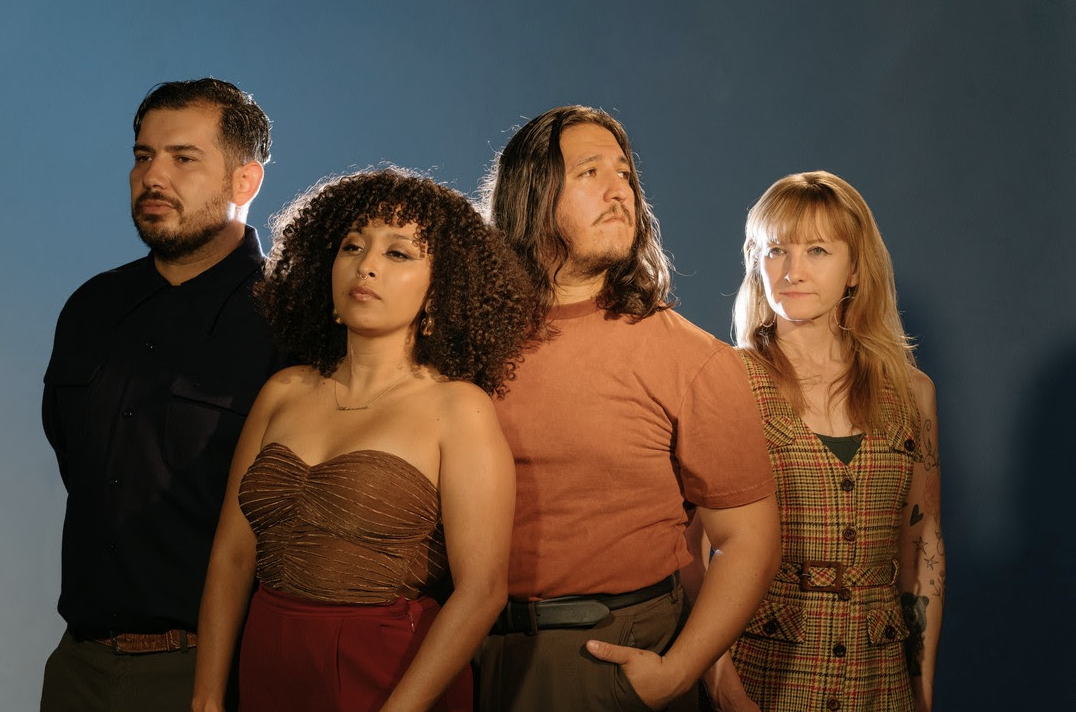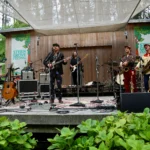Soul revivalists The Altons are poised to make waves with their debut LP, Heartache in Room 14, dropping February 14 via Daptone Records. Steeped in the rich sounds of Motown and Stax, the album captures the raw, heartfelt harmonies of Adriana Flores and Bryan Ponce, all while channeling the vibrant spirit of their LA roots. Produced by Daptone’s Bosco Mann, the record marks a bold evolution for the band, blending vintage soul with a modern edge—a sound that recently earned them a feature on Mary J. Blige’s Grammy-nominated Good Morning Gorgeous. With their Club Heartache Tour kicking off soon, including a stop at Bimbo’s 365 Club in San Francisco on March 1, we sat down with The Altons to talk soul, songwriting, and what’s next for the rising stars of the Daptone family.
This is your debut LP [on Daptone Records], and it’s being released on Valentine’s Day—a fitting date for an album titled Heartache in Room 14. What’s the story behind the album’s title and its connection to the themes of the record?
Bryan: I think it’s pretty cool how things work out! Initially, we were trying to get it out at the end of 2024 but it didn’t quite work out, when Feb 14th was mentioned it just seemed to feel right. The album itself isn’t just about the love you feel in a relationship, it’s more about the concept of love and all the heartache that comes with it. Whether it’s the love you have for a partner or the love you may have for a family member, the joy and pain it brings is what makes it so powerful.
Adriana: Once the date 2/14 was mentioned we said yes. Yes, that day is associated with romantic love and dates. We wanted to take on the day and release a record that explores familial love, platonic love, and the aches that come with it. Throw this record on that night, if you don’t have plans and cry with us, sing with us. Take a step back and take note of the different loves you have in your life and you’ll realize there are a lot more than you think.
Your music draws inspiration from the Motown and Stax eras while reflecting your Los Angeles roots. How do those influences shape the album, and how does your cultural background add a unique perspective?
Bryan: I think being born and raised in Los Angeles definitely helped not only with this album but also in developing our sound. On the weekends, one house may be having a party where they’re playing Cumbia, and just down the street there’s another house where someone’s mom is cleaning and she’s playing songs from bands like Los Angeles Negros, all while your neighbor is washing his car and listening to “Oldies” on The Art Laboe Connection. The different amounts of sounds we grew up taking in I think add a unique twist to the sounds that we’re putting out and I think the album is a reflection of that. Songs that may sound like they’re completely different but still feel like they’re all from the same neighborhood.
Adriana: Being in neighborhoods like ours we were exposed to all sorts of music. Backyard shows in high school were a mix of Hip Hop groups, Punk bands, and Cumbia bands. There was never a lack of musical inspiration in East LA. I was already finetuning my love for the Motown era and trying to adapt my poetry to this genre of music. When I met Joey and joined his band doing just this. Later down the line we met Bryan and joined his group, together we made up the Altons lineup known today.
Caitlin: I grew up listening to soul and Motown, whether it was with my dad in the car or on the oldies radio stations in my room. As a drummer, I have been influenced by the grooves of legendary drummers like Steve Gadd, Hal Blaine, Bernard Purdie, and other drummers who played on so many of those influential songs. Being in Los Angeles, I also got to be around legendary drummers and percussionists who I had the opportunity to play with and learn from.
Chris: Growing up in South Central pretty much most of my life all you heard was love songs all over my neighborhood. All these big tuff looking cholos rolling in their cars playing all the Motown stuff. Everything from Smokey, Marvin, The Supremes, Stevie Wonder, and the Four Tops. I also grew up hearing a lot of hip-hop and Spanish artists when I was a kid. I feel that culturally as a first-generation Mexican American you take a little bit from your parents’ roots and where they come from and sprinkle some of that into your style.
You’ve mentioned that this album represented a completely new approach to songwriting and recording for the band. What was the biggest challenge or revelation during that process?
Bryan: I think the biggest challenge for me personally was writing the song without the music. In the past, I’ve always liked to write lyrics and melody to an arrangement that has drums, bass, and a guitar kind of worked out, but for this record, we did the opposite and focused on developing the melody and lyrics first. Doing it this way allowed for the music to shape in any way we needed it to. It was like we had a blueprint and as a band we sat down with Gabe Roth and built the music for the song.
Adriana: Focusing on the melody and lyrics was something I had done in the past, being that I am limited to singing and not knowing an instrument. When I met Bryan and we began to write together he was the other piece. He provided the lyrics in my head with accompanying music! We had been writing like that for a while and this album’s process with Gabe Roth had us go back to the drawing board in terms of writing songs and reworking our process. Exciting and scary. Proud of the product and excited for people to hear it.
Caitlin: We had to work together to create the tightest groove and arrangement for each song, to bring out the story of the lyrics. The process of recording to tape together in the same room also meant that we all had to function as one unit at a high level.
Chris: Challenge? I think this was more of a learning experience. I’ve recorded in other studios and with different producers, but working with Gabe Roth makes you feel at ease. I like the way he makes us break down a song and to me that’s new. I’m used to getting a song recording it and calling it a day. He takes his time and makes sure that he gets the most out of you. To me that was awesome.
The vocal interplay between Adriana Flores and Bryan Ponce is such a cornerstone of your sound. How did that dynamic develop, and what’s the secret to maintaining such a harmonious connection?
Bryan: I think it developed at the end of writing our first album In The Meantime. The last song we wrote for it, which also happens to be the last track on the album, is a song in Spanish called “Maldito” and it’s the first time we had ever tried the vocal interplay. However, it wasn’t until the Tangled Up in You session that we started developing that sound. And all the credit to Gabe Roth, he was the one who pushed us to write songs with two singers in mind, rather than just one, he’s also the one who gave us the secret to maintaining that connection – A smile.
Adriana: I hate to admit it but smiling during a take helps, you can hear the difference. Yes during the Tangled Up sessions is when we were tweaking the idea of harmonies all the way through. Deciding to do it for 80 percent of the album was a doozy of a decision. It takes a lot of practice and a lot of smile singing.
On the weekends, one house may be having a party where they’re playing Cumbia, and just down the street there’s another house where someone’s mom is cleaning and she’s playing songs from bands like Los Angeles Negros, all while your neighbor is washing his car and listening to “Oldies” on The Art Laboe Connection.
The Club Heartache Tour will take you to iconic venues and festivals across the country. How do you approach connecting with different audiences, from intimate venues like Bimbo’s 365 Club to massive festivals like Bonnaroo?
Bryan: I think each audience is unique and it’s important to be aware of them each night. It helps with being there in the moment and avoids going into Autopilot. I believe that paying attention to each audience helps with creating a unique experience for them every night.
Adriana: Going off of what Bryan said previously, the audience and the energy they give you dictate the energy you give back. Sometimes a Bimbo’s crowd can be way wilder than a festival crowd and we are here to match it.
Caitlin: I love feeding off the energy of the people and the room, even tapping into the history of the venue. My goal with any crowd is to bring my full attention and intention to the music, the room, and the people.
Chris: My goal at every show is to hit that person right in the heart with our music. We’re human and we all go through good and bad times. And I hope that our music is therapeutic to that person and helps them out in a positive way.
Bimbo’s 365 Club in San Francisco is known for its classic, vintage vibe. Does playing in a venue like that shape how you approach your performance?
Bryan: I don’t think it does for me, I think it’s more of the audience that shapes how I approach it.
Caitlin: Since drums are an acoustic instrument, I will play depending on how the drums sound in the room and to me on stage. The vibe and history of the room may take me on an internal journey that might play out in my performance.
Your song “When You Go (That’s When You’ll Know)” being sampled by Mary J. Blige is a huge accomplishment. How did that collaboration come about, and how has it impacted the band’s trajectory?
Bryan: That one I believe happened randomly, maybe the producer heard the song somewhere and decided to sample it? I wish I had a better answer for this. If you ever interview Mary J Blige, please ask her how they found the song, I’m dying to know as well haha.
Adriana: I wish we knew, I’d like to believe she is somewhere jamming to the song. Like is this real life? Pinch me
Caitlin: Likewise, I don’t know how the producer came across the song, but I was so impressed with him creating that beat with my drum fills and other elements of the introduction to our song. Thought that was cool, and it was a bucket list moment for me as a drummer, to be sampled.
Chris: I don’t know. We got a call one day about this and we were shocked. I wish I had a better answer lol
What message or feeling do you hope listeners take away from Heartache in Room 14?
Bryan: I’m not sure if I have a specific message or feeling I would want them to take away from it, but rather that they take from it what they need. It could be something profound or could be nothing at all. I’m just happy with the work we did and hopefully, it resonates with people.
Adriana: Music has always been healing for me. When I was younger it helped me feel less alone. If I can do that for anyone it would be a win for me. I want them to throw this record on when they feel lonely and let us hang with you for the duration.
Caitlin: I hope people connect with the music and feel grounded and inspired by it.
Chris: Don’t be afraid to show your emotions. We all go through tough times and I hope that this album is something that helps people out in any way.
Your music combines nostalgia with a modern freshness. How do you strike that balance without losing authenticity?
Adriana: I’m glad people think so. I don’t think we go into the studio trying to sound like anyone else. We try to sound like ourselves and make music that resonates with us. The fact that people think it sounds like older music is a compliment, we have one of the best producers working with us and we are grateful for it.
Caitlin: All of us in the band listen to a wide variety of music and it naturally comes through in the music we create. We put our authentic selves into the music and I think that’s why it comes across that way.
The Altons play Bimbo’s 365 Club in San Francisco on March 1.







